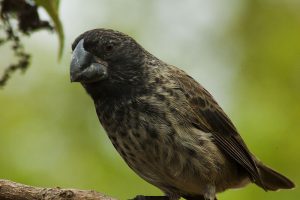Darwin’s finches always at the forefront
PDFRosemary and Peter Grant have been working for about 40 years on the finches of the Galapagos Archipelago. Their recent work on two species on Daphne Major Island has provided very concrete information on the effectiveness of natural selection and the speed with which it can operate on a population that is in extreme conditions.
One of the two species, Geospiza magnirostris, has a very large beak that allows it to feed on large seeds. The other, Geospiza fortis, has a medium sized beak, varying quite a bit from one individual to another. These birds feed on larger or smaller seeds depending on the size of their beaks. During a severe drought in 2004-2005, the amount of available seeds became limited. Those of the G. fortis, which had a rather large beak and could therefore eat fairly large seeds, found themselves in competition with the G. magnirostris and were at a significant disadvantage compared to their smaller beaked counterparts. At the end of the drought, out of 71 G. fortis individuals studied, 34 had died, mainly those with the largest beaks. This is what evolutionists call the “displacement of an ecological character”. It reduces competition for limited resources in an ecosystem and can be the beginning of a speciation process.
This field work was supplemented by genomic sequencing analysis (published in the journal Science on April 22, 2016). It highlighted the strong influence of a major gene, called HMGA2 (for high mobility group AT-hook 2), on beak size in the 13 species of Galapagos finches. In the G. fortis population studied, this gene is present in two variants (alleles), with the S allele (Small) giving a beak smaller than the L allele (Large). L/S heterozygotes have an intermediate size spout compared to L/L and S/S homozygotes. As expected, the S allele was found at a frequency of 61% in surviving G. fortis and only 37% in dead G. fortis. A very strong selection pressure had therefore played in his favour.
Not only are these results a very spectacular illustration of the Darwinian evolutionary process, but they also show that a single gene can play a major role in this type of process.






